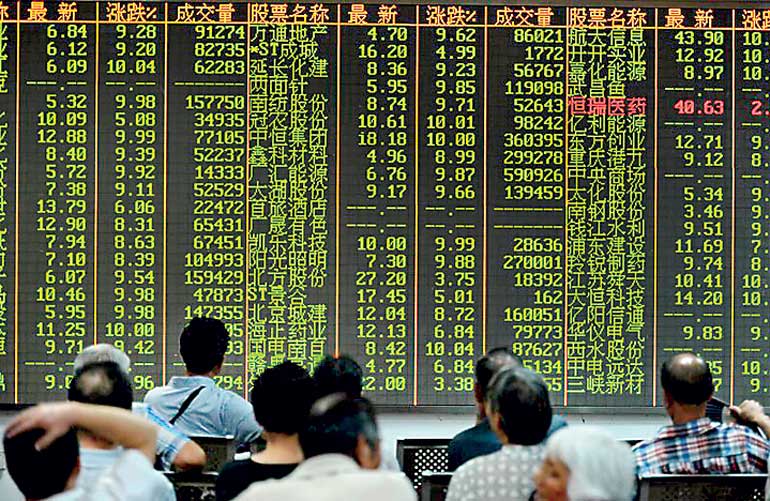Saturday Dec 20, 2025
Saturday Dec 20, 2025
Wednesday, 9 September 2015 00:00 - - {{hitsCtrl.values.hits}}

Shares rose in Europe and Asia on Tuesday while the dollar lost ground against the euro after trade data from China and Germany highlighted the divergent outlooks of the two heavyweight economies.
China said its imports fell far more than expected last month, adding to concerns about the world’s second-biggest economy’s contribution to global growth.
The data, which showed exports on the other hand fell less than expected, weighed on oil prices. However, Chinese stocks, which have fallen some 40% since mid-June, rose as some analysts calculated it could lead to further policy easing in the coming months.
By contrast, euro zone powerhouse Germany saw imports and exports hit record highs in July, pushing the trade surplus to a forecast-beating 22.8 billion euros.
“The contrast with what is happening in the German and Chinese trade balance is interesting and, at the moment, a positive for the European economy,” said KBC strategist Piet Lammens.
“But the steep decline in Chinese imports is further evidence of this slowing growth, which could weaken German data further out.” Worries over the Chinese growth outlook have led some analysts to question whether a widely expected rise in U.S. interest rates might be delayed, though some policymakers have suggested they would look beyond the recent market turmoil.
The pan-European FTSEurofirst 300 rose 1.5% while Germany’s DAX index gained 1.7%.
Britain’s FTSE 100 index rose 1.5%.
Wall Street, which was closed on Monday for a holiday, was expected to open higher, according to index futures. Earlier, Asian shares broke a six-day losing streak. MSCI’s broadest index of Asia-Pacific shares outside Japan was up 1.33% but remained within six points of a three-year low hit two weeks ago.
Japanese stocks fell, partly reflecting the data from China, one of its main trading partners. The Nikkei 225 index closed down 2.4%, taking it into negative territory for the year.
China’s Shanghai Composite index closed 2.9% higher, albeit on the lowest volume since late February. The CSI 300 index rose 2.6%.
The dollar strengthened against the safe-haven Japanese yen, last trading up 0.7% at 120.09 yen, but the euro gained 0.1% to $1.1182, rising for a third consecutive day.
The dollar index, which measures the greenback against a basket of currencies, fell 0.2%.
Yields on German government bonds, the euro zone benchmark, rose. Ten-year Bunds were yielding 0.69%, up two basis points.
Oil prices stabilized on Tuesday as strong German economic data and a year-on-year increase in Chinese crude imports balanced concerns about Asia’s economic growth and global oil oversupply.
German exports and imports hit record highs in July. Exports climbed 2.4 percent on the month to 103.4 billion euros ($115.6 billion) while imports grew by 2.2 percent to 80.6 billion euros. Traders said the strong German data had helped counter a further darkening of Asia’s economic outlook.
Brent futures LCOc1 rose 59 cents to $48.22 a barrel by 0853 GMT.
U.S. crude CLc1 was at $44.75 a barrel, down $1.30 since Friday’s close, weighed down by the closure of the largest crude distillation unit at ExxonMobil Corp’s (XOM.N) 502,500-barrels-per-day (bpd) Baton Rouge, Louisiana, refinery.
U.S. markets were closed on Monday for the Labor Day holiday, meaning there was no official close for U.S. crude.
Brent was down $1.39 from its Friday close.
Gold eased back towards its lowest since mid-August on Monday as stock markets firmed and the dollar steadied, and after US payrolls data failed to provide clarity on the timing of a Federal Reserve rate hike.
Having failed to benefit from recent turmoil in stock markets after China devalued its currency last month, gold is now struggling to find direction outside of US monetary policy, analysts said.
Spot gold was down 0.3% at $1,119.10 an ounce by 2:30 p.m. EST (1830 GMT), while US gold futures for December delivery were down $3 an ounce at $1,118.40 with activity subdued by the US Labour Day holiday.
“Gold didn’t do enough during the equity market turmoil in China, or the yuan devaluation in China. People were expecting it to go up and it didn’t, so they lost interest,” Citi analyst David Wilson said.
“The market has already assumed that there may not be a September rate hike, so if anything, if there is a hike, there is more risk on the downside.”
Spot gold lost 1% last week and has fallen more than 5% this year, largely on expectations for a rise in US interest rates.
That would lift the opportunity cost of holding non-yielding bullion while boosting the dollar, in which it is priced.
Bullion traders said uncertainty over the timing of a hike will keep gold under pressure until the Fed meets on 16-17 September.
The Fed has already indicated that the timing of a hike is largely data-dependent.
Friday’s non-farm payrolls report showed the US economy added fewer jobs than expected last month, though the unemployment rate fell to its lowest since 2008.
“The number was too good for those who hoped that the Fed would postpone the rate hike, and too little for those who were hoping (they’d go ahead with) it. That’s why on the gold side, the market just got stuck,” Julius Baer analyst Carsten Menke said.
European stocks rose on Monday, lifted by mining and commodities giant Glencore after it pledged to slash its debt by a third. The dollar index steadied.
Gold prices got little support with the resumption of trading in key gold consumer China after public holidays. Premiums on the Shanghai Gold Exchange were steady at about $4 an ounce on Monday, indicating stable buying interest.
Among other precious metals, silver was down 0.6% at $14.48 an ounce, while platinum was down 0.6% at $982.75 an ounce and palladium was up 1.2% at $578.25 an ounce.